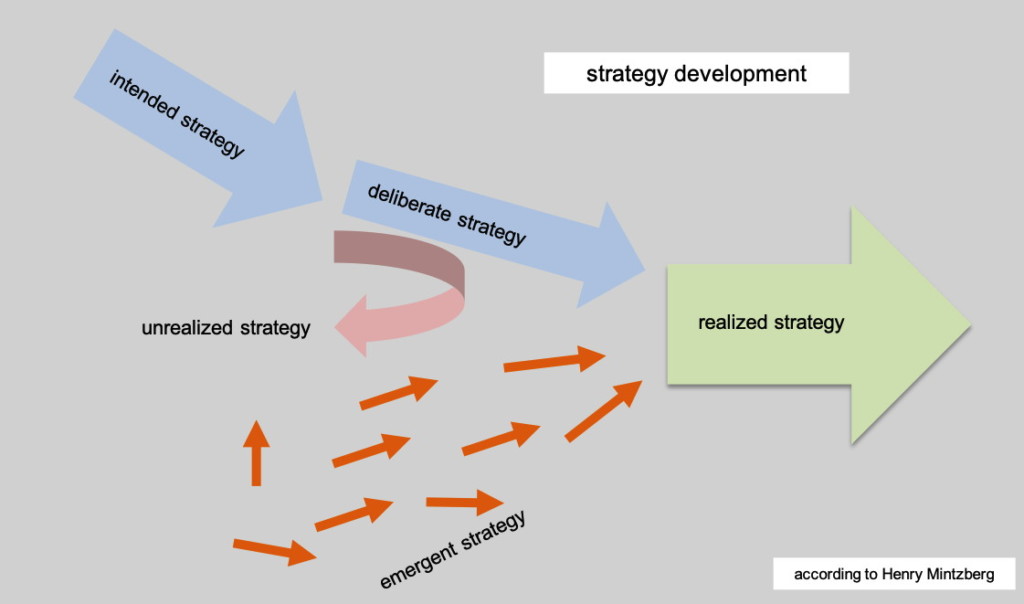Strategy development in uncertain times – how it succeeds and what a good strategy does for you. (Only in german language)
Podcast: Play in new window | Download
What’s next for the company? Does your strategy provide all employees with comprehensible answers and sufficient orientation? Also in the medium and long term? In this podcast episode, I talk with my colleague Dieter Kannenberg about approaches and methods of strategy development as well as typical mistakes in strategy work. Here is an overview for you.
The importance of strategies for companies
The strategy aligns the company and equips it for the future. It provides orientation not only for managers but also for all employees. The strategy development process must do justice to this. And it makes sense to combine thinking (conception) and acting (action). Bringing the important players in the company on board, even across hierarchies, is a prerequisite for this.
- Who has the best contact to the customers?
- Where are the experts who know all facets of the production processes?
- Who is particularly well networked – within the company, but also across borders?
Once this selection has been made, the joint discourse must be well organised and moderated in a goal-oriented manner.
Useful approaches to strategy development
Within the framework of strategy development, it is important to keep looking in two directions with the help of suitable analysis tools:
a) Outside-In: The view from the company to the ‘outside’
What is the situation in the company’s environment? Which trends and technologies are on the rise? Where are new markets opening up? What opportunities and risks are discernible? How do you get relevant and data? etc.
b) Inside-Out: Looking inwards
How is the company positioned? What knowledge and what accesses are available? Which products are running successfully and what potential do these products have for the future? What is the company’s financial strength? etc.
The – possibly also unpleasant – answers to such questions must then be combined. A SWOT analysis helps visualise strengths, weaknesses, opportunities and threats.
c) Emergent versus deliberate strategy
A realistic strategy path results (cf. Mintzberg) from the conscious and the emerging (emergent) strategy. With this approach, too, it is important to bring the perspectives together.
The planned, deliberate strategy makes clear to all managers and employees, among other things, what the organisation wants to achieve. At the same time, it provides information about what is NOT wanted.
The emerging strategy allows for contingency and encourages experimentation. However, moving along this path alone carries the risk of ‘muddling through’: hoping for opportunities and coincidences, reacting haphazardly and without direction, and thus wasting valuable resources.
Strategy development despite and precisely because of increasing uncertainty
What is the use of a strategy if it feels like everything is constantly changing anyway? In many organisations, a certain fatigue with change is spreading. And it is precisely then that joint work on the strategy promotes forward thinking in the company. Managers and employees can prepare themselves better for upheavals and changes – and everyone pulls together. Experience has shown that the scenario technique helps to prevent blinkered thinking and to broaden perspectives. A process moderated with the scenario technique results in several future scenarios that are considered realistic by the participants. Thinking through these (and by the way, especially the uncomfortable ones) in the team is important to stay awake and to be able to react quickly to changes in the environment.
You can find a detailed description of a strategy development with the scenario technique in this project report.
3 tips for your successful strategy work
- bring thinking and action together by including practical knowledge and expert knowledge in the discussion of strategy.
- set priorities and, despite all the planning, also give the emerging strategy a chance.
- set indicators by which you can recognise deviations in the environment at an early stage.
…and typical traps and mistakes
In corporate practice – unfortunately – typical ones show up again and again. What are these?
- Only the so-called ‘show side’ of the strategy is played with. Great posters hang on the walls, elaborate flyers are developed and big plans are made. What is missing, however, are concrete measures and coordinated activities.
- The new strategy is broken down into small parts and what follows is pure micro-management. There is no room for co-thinking or even rethinking. Working with the strategy degenerates into working through action plans with countless to-dos that ultimately paralyse.
Conclusion
A strategy describes where the journey is to go. At the same time, those involved at all hierarchical levels must remain open to imponderables. Everyone knows the relevant fields of action and their responsibility in implementing the strategy. The necessary time resources are available. And last but not least, there is room for experimentation.
In this sense: plan and at the same time remain open and prepared for all the surprises that the new year has in store. We wish you every success in doing so.
Anneli Gabriel
You can also find our podcast (in german language) on Spotify and Apple Podcasts.




